Top News
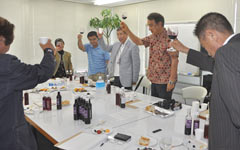
March 17, 2013 Ryukyu Shimpo
On March 10, at Brain Okinawa in Kumoji, Naha, the Cooperative Association Okinawa Industrial Project held the first ever Tonaki wine tasting event. The association plays a leading role in island economic development projects, including the cultivation of the local grape Ryukyu ganebu on unused arable land in Tonaki Village. The grapes are then used to make wine and to encourage job creation.
The crop volume was low because of last year’s typhoons, and the ripeness was not up to standard, having a strong acidic taste. But even so, people involved in the project celebrated the completion of trial products and that fact that at least they have started.
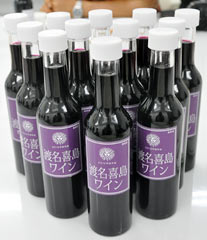
The first Tonaki wine trial products.
Ryukyu ganebu has previously attracted little attention because of its meager flesh and strong acidic taste, but research carried out by Osaka Prefectural University shows that when fruit and leaves are exposed to ultraviolet light, they synthesize the highly functional components for resveratrol, which is beneficial for anti-aging.
On this occasion, 9.5 kilograms of wine were made from 15 kilograms of fruit. Researchers involved in cultivation and the ten staff members from the Nago Pineapple Winery who made the product attended the tasting and enjoyed the first Tonaki wine. The participants commented about it being a very young wine and having a beautiful color.
Professor Ryosuke Mochioka of the University of Kagawa, who researches cultivation methods, explained, “It has a strong acid taste because typhoons affected the timing of the picking season.” Daisuke Toda, Sales Division Chief of the Nago Pineapple Winery who was in charge of test production, said, “Making good wine depends on the quality of the fruit. We need greater volume and high-sugar content. But at last we have got as far as the start line.” From now, Okinawa Industrial Projects aims to commercialize the wine. In addition, next year they are planning to test-market cosmetic products that use Ryukyu Ganebu. For more information about the project, call Okinawa Industrial Projects on 098 (861) 7007.
(English translation by T&CT, Megumi Chibana and Mark Ealey)
Go to Japanese
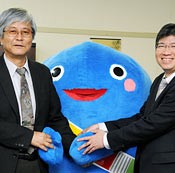
March 23, 2013 Ryukyu Shimpo
The Ryukyu Shimpo newspaper and the Faculty of Education at University of the Ryukyus will cooperate to deliver a newspaper course from the 2013 academic year. The course aims to teach the role and structure of newspapers by introducing examples of NIE (Newspapers In Education) to students who hope to become teachers.
On March 22, in a signing ceremony held at the University of the Ryukyus in Nishihara, Yasutaka Hanashiro, the chief of the editorial office of the Ryukyu Shimpo, and Koshi Inoue, the head of the Faculty of Education, agreed to create the new course, which will start in April.
The faculty sees the new course as being related to modern and regional educational subjects in the category of general classes. It will be a compulsory elective.
Inoue said, “I have been interested in NIE for a long time. I hope that we will work together in the future and share our accomplishments.” Hanashiro said, “I hope that the students get an idea of how society works and use what they learn to their benefit after graduation.”
Hitoshi Fukuhara, the assistant managing editor, chief of news and the NIE promotion division at Ryukyu Shimpo, will teach the course for the first semester. The course will introduce the history of NIE, changes in academic achievements and the social role of newspapers in Okinawa.
(English translation by T&CT, Mark Ealey)
Go to Japanese
March 23, 2013 Ryukyu Shimpo
Prime Minister Shinzo Abe’s administration submitted an application to the Okinawa Prefectural Government for approval to reclaim land for the relocation of the U.S. Marine Corps’ Futenma Air Station to the Henoko coastal area in Nago. This is nothing less than a denial of democracy in Japan.
Since 1996, when the U.S. and Japanese governments agreed to relocate Futenma Air Station, the people of Okinawa have actively discussed the issue of base relocation with the prefectural authorities through gubernatorial elections, prefectural diet member elections and prefectural assembly elections, and through mayoral elections in Nago and Ginowan.
Okinawan Governor Hirokazu Nakaima wants the facilities relocated outside of the prefecture, and after considerable discussion, all 41 heads of the municipalities and assembly members in Okinawa oppose relocation within Okinawa. Nakaima has even said, “Relocation within the prefecture is impossible.” Four members of the ruling Liberal Democratic Party who were elected from Okinawa have publicly promised to oppose relocation within the prefecture.
There is no way that we can tolerate the central government’s discriminatory treatment of the Okinawan people by letting them ignore what is clearly a consensus of opinion in the prefecture.
The mayors of the municipalities and chairmen of the various assemblies in Okinawa visited Prime Minister Shinzo Abe’s official residence this January to give him a petition requesting that the U.S. and Japanese governments abandon the idea of relocating the facilities at Futenma Air Station somewhere within the prefecture, and instead demanding the closure and removal of the base. Abe should respect the will of the Okinawan people, which is greatest common measure for them.
Former Defense Minister Satoshi Morimoto said that an alternative facility for the relocation of Futenma Air Station being constructed in Okinawa was not a decision made from a military standpoint but from a political one. From a military perspective, no reasonable grounds for relocation of the base within Okinawa exist.
Pro-Japanese intellectuals in the United States, including political scientist Joseph Nye have proposed that the U.S. government moves the Marines from Okinawa to bases in Australia or back to the United States. Top bureaucrats in the Ministry of Defense have said that attempting to justify stationing the Marines in Okinawa as a deterrent force, which is major premise for the deployment of the Osprey to Okinawa, lacks persuasion from a military perspective. Others have pointed out that advancements in military technology mean that there is now no particular military advantage to be had by stationing Marines in Okinawa.
Bureaucrats in the ministries of defense and foreign affairs continue to be fixated by the idea of relocating the base to the Henoko district of Nago despite the changing environment surrounding Futenma Air Station and the U.S. Marines presence in Okinawa.
Abe and President Barack Obama should allow civilian control to function properly. Action is needed in order to drastically change the U.S.-Japan relationship and to regain the trust of the nation with regard to diplomacy and security policy. They should make high level political judgments and seriously consider closing and removing Futenma Air Station and moving the Marines off Okinawa to somewhere outside the prefecture or outside Japan.
It is ridiculous for both governments to waste time and effort in clinging onto the relocation of the base within Okinawa. This is simply a forlorn hope. The U.S. and Japanese governments should not allow the facilities at Futenma Air Station to stay where they are and should remove the danger posed by the base as soon as possible, but both governments should follow democratic procedures. If the United States and Japan are truly democratic countries, they will respect the content of the petition submitted by Okinawan leaders.
(English translation by T&CT, Mark Ealey)
Go to Japanese
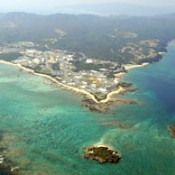
March 23, 2013 Ryukyu Shimpo
The central government has submitted an application to the Governor of Okinawa for permission to reclaim land off Henoko, Nago in order to commence the relocation of U.S. Marine Corps Air Station Futenma. At 3:40pm on March 22, officials of the Okinawa Defense Bureau delivered the documents to a local office of the Okinawa Prefectural Government (OPG). They also presented a letter of consent from the Nago Fisheries Cooperative, which has the fishing rights for the sea off the coast. If all the documents are in order, the OPG will accept the application in the course of the next week. Governor Hirokazu Nakaima will decide whether or not he will allow the landfill, after hearing from the Nago mayor and others, in a term of from six and a half months to eight and a half months.
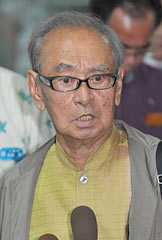
On March 22, at the Okinawa Prefectural Government Office, Governor Nakaima again argued for relocation outside Okinawa when he heard that the central government had submitted its application for approval to reclaim land off Henoko, Nago.
Governor Nakaima and all the heads of the 41 municipalities have been calling for the relocation of the facilities currently at Futenma to somewhere outside the prefecture. The Okinawa Prefectural Assembly is considering adopting a protest resolution and submitting a written statement of opinion to the central government. Protests from Okinawa are bound to increase given that the Abe administration clearly intends to force through the Henoko relocation. The application documents state that the landfill area, including five hectares to be used for work-yards, will be about 160 hectares, with a total landfill soil volume of about 21 million cubic meters. It will take five years to complete the landfill.
When talking to reporters that evening, Prime Minister Shinzo Abe commented, “Our basic policy is to not allow the facilities at Futenma to become a permanent fixture. I want to make every effort to reduce the burden on Okinawa.” He also said that he intends to promote the planned relocation of the facilities at Futenma to Henoko based on the bilateral agreement between Japan and the United States.
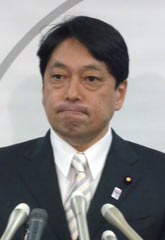
In the afternoon of March 22, at the Ministry of Defense, Defense Minister Onodera held a press conference regarding the application to apply for the reclamation of the coastal area of Henoko, Nago.
In a press conference that evening, Defense Minister Itsunori Onodera said, “We have reached an agreement with the Nago Fisheries Cooperative, so we moved quickly to submit the written application for approval of the landfill. We will strive to get approval from the Governor of Okinawa, and will also exchange opinions with the Okinawa Prefectural Government. This is the first time that we have got as far as the starting line.”
At a board meeting held that afternoon, the Nago Fisheries Cooperative decided to submit a letter of consent to approve the landfill, and at 3:00pm they handed this to Defense Agency staff.
Hiroshi Kohagura, the president of cooperative, said, “We have already signed a memorandum of agreement with the Okinawa Defense Bureau on the total amount of compensation to be paid for fisheries and other measures for development. We are ready to present it at any time.” He declined to comment on the amount of compensation.
According to the local office of the OPG, six Okinawa Defense Bureau officials left five boxes containing the documents on the counter of the General Affairs Section on the third floor of the office building. They left a few minutes later. Just five minutes earlier there was a telephone call to the effect that they would deliver the application documents to the Seashore Disaster Prevention Division of the OPG.
When Prime Minister Abe met President Obama in February, he indicated that the government would apply for the landfill by the end of March. The Abe administration was probably determined to show the United States that, based on what has been agreed, they are actually moving to relocate the facilities at Futenma Air Station. They are trying to show that local people have agreed with the landfill by attaching the letter of consent from the Nago Fisheries Cooperative, which is not actually required as part of the application procedure.
The governor of Okinawa criticized the central government, saying that the facilities at Futenma “will become a permanent fixture.”
On March 22, Governor Hirokazu Nakaima commented that while the central government said that “Futenma cannot be allowed to become a permanent fixture, … because it will take from five to ten years to relocate the base to Henoko this effectively represents a policy of making the base into a permanent fixture. This is unrealistic and impossible.” Nakaima again asked for the base to be relocated outside of the prefecture, saying that, “to resolve the Futenma issue, the best option is to move the facilities outside of Okinawa.”
The governor sharply criticized the governments of Japan and the United States, saying, “Normally speaking, people don’t start things without studying the feasibility, but in this case they have just decided by themselves to go ahead.”
With regard to whether or not he will approve the application for land reclamation to build the base, the governor said that he will decide after looking at all aspects, including how the central government has corrected measures that the governor pointed out in the process of the environmental impact assessment.
(English translation by T&CT, Mark Ealey)
Go to Japanese
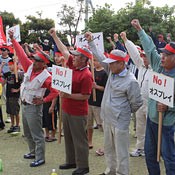
March 18, 2013 Ryukyu Shimpo
On March 17, in a hall in Shirohara in Ginoza, local people held a protest rally against the deployment of the Osprey. Since being deployed in Okinawa these aircraft have carried out low-flying and night-time training over Shirohara Ward.
About 120 people, almost half of the residents of the ward, took part in the rally. Hoping to regain a quiet life, they adopted a resolution calling for (1) an immediate end to Osprey flight training above Shirohara and (2) a swift removal of the landing area. In cooperation with Ginoza Mayor Atsushi Toma, Shirohara Ward will send this resolution to Prime Minister Shinzo Abe and President Barack Obama, and to the U.S. forces in Okinawa and the Okinawa Defense Bureau.
On behalf of the rally organizers, Ward Chief Jiko Omine stated, “We have suffered from noise and vibration from the training throughout the day and night. We cannot allow this to become an accepted everyday occurrence.”
People from all age categories spoke – from elementary school pupils to members of senior citizens’ clubs and the administrative committee. Shuji Arakawa and Yui Inamine, both fourth grade pupils of Kanna Elementary School, said that the noise has disturbed their classes and that they will continue to protest until the government removes the Osprey aircraft, even if it takes five or ten years.
Tadanobu Izumi, who lives very near the landing area at Shirohara, said, “President Obama, please take the Osprey back to the United States. Prime Minister Abe, please give us back our peaceful environment, in which there are no Osprey.”
(English translation by T&CT, Lima Tokumori and Mark Ealey)
Go to japanese
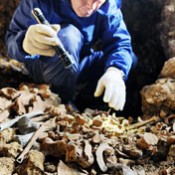
March 17, 2013 Ryukyu Shimpo
At least ten sets of remains were found recently at a former Imperial Japanese Army shelter near the boundary between Shuri in Naha and Urasoe. Naha resident Isamu Kuniyoshi who has collected remains for many years, and his friends dug in the shelter and collected many things such as army boots and helmets, ammunition, grenades and flares. A small structure just a few meters wide, the shelter is located on top of a hill overlooking the former headquarters of the 32nd Army at Shuri. Kuniyoshi and his colleagues excavated the site over a period of about two weeks, finding remains and personal effects scattered in the sediment.
The number of thigh bones suggest that there could be the remains of at least ten people inside. They also found skulls, pelvises, collarbones and parts of jawbones with teeth attached. They have dug about three or four meters in from the entrance, but soil collapsed in the shelter has blocked further progress.
“No doubt as we go further in, we will find more remains and personal effects,” said Kuniyoshi. So far they have found 120 bullets and 25 grenades, including Japanese bullets with a square cartridge and American bullets that are cylindrical in shape. Ordnance left behind would seem to be anti-tank shells. They also found square sake cups packed with explosive “fulminating powder” that Japanese soldiers would wear in some form of jacket as they dashed themselves against enemy tanks.
(English translation by T&CT, Mark Ealey)
Go to Japanese
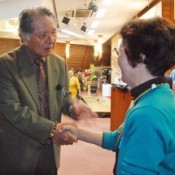
March 16, 2013 Ryukyu Shimpo
On March 15, the One-foot Film Movement, a non-profit organization made up of Okinawan locals who purchased footage filmed by the U.S. military during the Battle of Okinawa, ended its 30-year operations at a ceremony held at the Yashio Rest House in Naha. The organization started in 1983 as the Civil Movement to Provide Children With Lessons of the Battle of Okinawa. It purchased the footage (about 33.5 kilometers and 50 hours worth) from collectors in the United States using donations both from within Okinawa and further afield. Members of the organization brought the operation to a close commenting that many people had relived their experiences in the Battle of Okinawa through the footage that they had collected. Hiroaki Fukuchi, a representative of the organization, said, “I am sure that the younger generation will continue the One-foot Film Movement in some new form of peace movement.”
(English translation by T&CT, Mark Ealey)
Go to Japanese
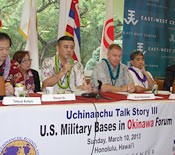
March 12, 2013 Chikako Nago of Ryukyu Shimpo
The Uchinanchu Talk Story 3 was held on March 10 at the East-West Center of the University of Hawaii. Two keynote speakers and five panelists exchanged opinions on the subject of “U.S. Military Bases in Okinawa.” Hawaii State Governor Neil Abercrombie, who was invited as a guest speaker, suggested moving Marine Corps personnel from Okinawa to Pohakuloa on the island of Hawaii. The state has started planning for the building of family residential facilities to host Marines. He said that after talking to residents he seek approval from the state legislature and the federal legislature.
Governor Abercrombie suggested that relocating the Marines to Guam is financially difficult and that Guam does not have the capacity to host them. He also said that relocating the Marines to Guam with financial support from the Japanese government is not a sustainable option, and went on to say that it would only worsen the relationship between the Japanese government and Okinawa.
About 150 people took part in what was the first public forum in Hawaii to discuss the U.S. military presence in Okinawa. The event was hosted by the University of Hawaii students’ Akisamiyo-! Club, the East-West Center, and the Worldwide Uchinanchu Business Network. Panelists were professor of constitutional law of the University of the Ryukyus Tetsumi Takara, United States Marines Corps Colonel Grant Newsham, director of the Regional Security Policy Division at the Executive Office of the Governor of Okinawa, Naoya Iju, senior research fellow at the Research Institute for Peace and Security, Tetsuo Kotani, and freelance writer Tomohiro Yara.
Former chair of the Center for Japanese Studies at University of Hawaii, Robert Huey, who served as the moderator, summed up the forum stating, “Everyone agreed that the current situation in Okinawa is not desirable. Let’s try to explore the scenario for the United States and create the best for Okinawa.”
(English translation by T&CT, Megumi Chibana and Mark Ealey)
Go to Japanese
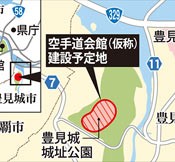
March 14, 2013 Michiyo Yonamine of Ryukyu Shimpo
The Karate-do Hall Planning Committee has put together a draft plan for the Tomigusuku Castle Park in Tomigusuku to be the construction site of the Karate-do Hall that will become a hub of Okinawan karate. In the near future, Governor Hirokazu Nakaima will decide upon the specific details. To date, in addition to Tomigusuku, the Okinawa Prefectural Government (OPG) had listed Naha, Urasoe, Okinawa City, and Itoman as candidate sites.
The committee took into consideration aspects such as its ease of access from Naha Airport, its historical significance as a home of traditional culture, the proximity of accommodation facilities, and the distance from the Okinawa Prefectural Hall of Martial Arts in Naha, which will be operated in conjunction with the Karate-do Hall. Among other things, they chose Tomigusuku as the location because of the convenient access and the traditional culture heritage of the area.
The park was closed in 2003. Kagoshima-based Iwasaki Sangyo Co., the former operator of the park and current landowner, has agreed to sell it. The Tomigusuku Municipal Government will start talking with the owner about a sales contract after the governor has made his final decision. The OPG will purchase the land with lump-sum subsidies for Okinawa development.
The construction of the Karate-do Hall is one of Governor Nakaima’s pledges made in the gubernatorial election of 2010 and the OPG has promoted it as a project to commemorate the 40th anniversary of Okinawa’s reversion to Japanese sovereignty. On March 7, at a regular meeting of the Okinawa Prefectural Assembly, the governor stated that the OPG will decide upon the construction site within fiscal 2012, as well as the schedule of construction, the basic plan of the Karate-do Hall including its scale, contents and administrative plan. The OPG will get to work on the hall design this year.
To begin with, the Okinawa Prefectural Government had planned to choose the construction site by last November but in the end the decision was significantly delayed due to time being taken in the selection process. The government budgeted 48.35 million yen for the basic plan in its initial budget for 2012. In the initial budget for 2013, they included 20 million yen from lump-sum subsidies in order to look into the administration, management and exhibition program. The cost of design will be covered from supplementary budgets.
(English translation by T&CT, Lima Tokumori and Mark Ealey)
Go to Japanese
March 12, 2013 Ryukyu Shimpo
Real estate management company Ichigo Group Holdings will construct an eight-megawatt solar power plant on what used to be the Yukari Farm in Futami, Nago.
This will be the biggest solar plant in Okinawa, and the largest owned by the company in Japan. Ichigo Group Holdings is known for employing Hiromi Miyake, the silver medalist in the women’s 48-kilogram division of the weightlifting at the London Olympics.
On March 7, Nago Municipal Office entered into a contract with Ichigo ECO Nago Futami Power Plant to lease its land for the mega-solar power plant. According to the municipal office, the Ichigo Group will start surveying and construction from this April and commence business operations from April 2014. Ichigo Group Holdings has already established a contract with the Okinawa Electric Power Company to sell the electricity that is generated.
According to the contract, 152500 square meters of municipal land will be leased to Ichigo Group Holdings for 305 million yen per year. The first contract period is expected to be about one year, and they have to then extend the contract for 20 years when the company actual starts business.
In November 2012, the Ichigo Group set up an ecology-related business company called Ichigo ECO Energy and became involved in the mega solar business. A municipal official said, “Our policy is to promote natural energy and the Ichigo Group’s idea fits in with this, so we want to push ahead with the plan.”
The municipal office and Ichigo Group will announce the business plan officially at a later date.
(English translation by T&CT, Hitomi Shinzato and Mark Ealey)
Go to Japanese
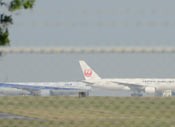
March 13, 2013 Ryukyu shimpo
At around 1:07pm, on March 12, at Naha Airport, a F-5 fighter belonging to the Japan Air Self-Defense Force (JASDF) stopped on the runway after its left tire became flat during landing. According to a spokesperson for the Naha base no injuries were reported. The runway was closed for about one hour and about 2200 passengers on at least 15 flights, most of them incoming, experienced disruptions.
Some of the aircraft had to land at Kadena Air Base or at airports outside Okinawa, and some even turned back to the point of departure.
According to a spokesperson for the base, the fighter belongs to the 204th Squadron, 83rd Wing at Naha Air Base. The cause of flat tire is being investigated. The accident took place when the fighter returned to Naha base after it was scrambled to intercept an intrusion into Japanese airspace by foreign aircraft. The airport resumed its takeoffs and landings at 7:02pm after JASDF personnel had collected up all the pieces of tire off the runway.
Many incoming and outgoing flights were affected. They were mostly inbound All Nippon Airways and Japan Airlines flights from the main islands of Japan, but it also disturbed flights scheduled for departure. There was a delay of around two hours.
(English translation by T&CT, Mark Ealey)
Go to Japanese












 Webcam(Kokusai Street)
Webcam(Kokusai Street)


